|
|
Phalaris

|
|
 |
|
|
The appearance of Phalaris onto scene in England ushered in a new era in Thoroughbred breeding. He came along at a time when the longer races were losing their popularity and the speed horses were taking center stage, horses like himself, The Tetrarch, and the sons and daughters of Orby. Phalaris' many successful sire sons dominated breeding worldwide for generations, until by the end of the Twentieth Century, his male line dominated all others through such important stallion descendants as Nearco, Nasrullah, Bold Ruler, Royal Charger, Northern Dancer, Native Dancer, and Buckpasser.
Phalaris was bred by the Seventeenth Earl of Derby, who, upon the advice of his racing manager George Lambton, and bloodstock advisor, Walter Alston, purchased his dam Bromus following the death of her breeder, Joseph H. Houldsworth, in 1910. She had only posted one win in ten starts, in the Seaton Delaval Plate at two, and she was the only winner produced by her non-winning dam, so one has to conclude that Lord Derby's men were more interested in her conformation and unusual pedigree than racing ability and depth of family.
Bromus traced back to both of Houldsworth's foundation horses, the sprinting stallion Springfield (to which she was inbred 2x3) and her fourth dam, Sunshine, by Thormanby. For Lord Derby, she produced three winners, but only two foals of note, Phalaris and Hainault. Hainault (br.c. 1914 by Swynford) was the younger of the two, and despite chronic unsoundness due to a knee injury as a yearling, and being unraced at two, he won five races from eight to sixteen furlongs, including the Bottisham Plate, Zetland Plate, Final Plate, and Offord Plate at three; and the Newmarket Triennial and Newmarket Spring Stakes at four. Hainault was a useful sire during his short life (he died when just twelve years old), and left two daughters of note, Rainstorm (dam of the sprinter Golden Cloud) and Clang (granddam of Derby winner Nimbus).
Phalaris was sired by Polymelus (b.c. 1902 by Cyllene - Maid Marian by Hampton), a good racehorse who showed very good form every year he raced, from two to five, with eleven wins from thirty-one starts, including the Champion Stakes, Cambridgeshire Handicap, Duke of York Stakes, Princess of Wales Stakes, Richmond Stakes, and Rous Memorial Stakes; as well as a second in his year's St. Leger (to Challacombe). A versatile horse, Polymelus' best distance was about ten furlongs. He tended to run better late in the season and preferred Newmarket to all other courses. A horse with a very long stride, he was built very much like his sire Cyllene, with a long, flat top line, level croup, exceptionally long forearm and short cannon.
Polymelus was a great success at stud at Solly Joel's Maiden Erlegh Stud, getting classic winners Pommern (1915 English Triple Crown), Humorist (1921 Derby), Fifinella (1916 Derby and Oaks), Black Jester (19.. St. Leger), Cinna (1920 1,000 Guineas), *War Cloud (1918 Preakness), Corcyra, *Polymelian, and Phalaris.
Phalaris on the Turf
Phalaris was foaled on May 16, 1913 at the Derby stud in Newmarket and went into the hands of Lord Derby's trainer George Lambton when a two-year-old. That season he started three times, winning twice, and unplaced once, that in his debut in the First Spring Two-Year-Old Stakes (Newmarket) won by Foxgrove. Next time out, he won the Stud Produce Stakes (five furlongs, Newmarket) by a head over Condottiere, who carried four pounds less than his 123. In his third and final start of the year, the Redmere Nursery Plate Handicap (five furlongs), Phalaris carried 126 pounds and despite a bad start he won by two lengths, conceding weight all around, at least five pounds to upwards of nineteen pounds. On the Free Handicap, he was tied with the filly Telephone Girl as fifth highweight at 117 pounds (the topweight was the filly Fifinella, also by Polymelus, at 126. Fifinella won the next year's wartime substitutes for the Derby and the Oaks).
At three, Phalaris ran seven times and won three of them. Lambton pointed him along the typical path to the classics, but he was third in the mile Craven Stakes behind Sir Dighton and Roi d'Ecosse, who dead-heated for the win, was soundly beaten when unplaced in the 2,000 Guineas, won by Clarissimus. Phalaris was dropped back to lesser company in the Stewards' Handicap, but even under just 99 pounds, ran poorly. In the Beaufort Stakes (seven furlongs), with 119 pounds, he bounced back to winning form with an easy victory over older runners from a small field of four. In the St. George's Handicap (six furlongs), Phalaris romped home by six lengths carrying a feathery 113 pounds. This was the last time he was so lightly regarded. In the Royal Stakes (ten furlongs), he was assigned 124 pounds and won again over two others. In the Limekiln Stakes at the same distance, he had 120 pounds in the saddle but could only run second in the field of eight.
Returning at four, Phalaris went postward nine times and won seven. After his season debut finishing a close second in the Crawfurd Handicap to Verdun (Phalaris giving him 22 pounds), the Derby colt went on a tear with seven straight wins. The first was the Bretby Handicap (six furlongs), then the Chesterfield Course Stakes, a furlong shorter in distance. In the St. Ives Handicap (five furlongs, Newmarket), he won under 131 pounds, giving from five to 47 pounds to his rivals. For the Bury St. Edmunds Plate (a mile), he faced the dual classic-winning filly Fifinella, and beat her. Dropped back to sprinting, he won the Snailwell Stakes and the Challenge Stakes, both at Newmarket, the first at five and the second at six furlongs.
Phalaris then appeared in the entries for The Whip, a race run over two miles and 118 yards. Assigned 140 pounds, he went alone to the post and scored his first walkover victory, so gaining a win at the two mile distance. In his next start, the Cambridgeshire Handicap (nine furlongs), he was assigned 126 pounds but finished up the track, tenth behind Brown Prince (giving him 21 pounds), Planet (also getting 21 pounds from Phalaris), and Grand Fleet (getting 15).
Lambton brought Phalaris back at five, and he won all but one of his five starts. In the five furlongs Abingdon Plate, he beat Syndrian by a half length carrying 147 pounds. In the mile June Stakes, he carried 134 pounds to victory over Brown Prince and Planet. In the Beaufort Stakes (five furlongs), he was unexpectedly off the board carrying 146 pounds. In the Lanwades Plate (seven furlongs), he toted 141 pounds with the next high weight in the field of eight carrying just 108 pounds, and Phalaris still won. In his final start of the year, the six furlongs Challenge Stakes, he walked over for the second time.
This is the record of a great weight carrier, since Phalaris won carrying more than 130 pounds on at least seven occasions, and won carrying more than 140 pounds three times, including once with 147 pounds aboard. Lambton took pity on the horse for the July Cup, in which the handicapper assigned Phalaris 154 pounds, and the Derby colt did not start. Phalaris retired with a record of twenty-four starts and sixteen wins. Although he won contests at ten furlongs and a mile, he was at his most brilliant at five and six furlongs, and failed when he ran longer if the pace was fast.
Although Phalaris was a stablemate of the brilliant sprinting filly Diadem, Lambton never pitted them against one another for the obvious reason -- one of them would have had to lose. The trainer ran them together just once in a trial over six furlongs, and Lambton "gave the nod to the filly by a nose." It should be noted that Diadem was one of Lambton's favorites, so his judgment may have been biased.
Lambton's observations on Phalaris are worth mentioning. "Polymelus and Phalaris, as three-year-olds, were neither of them able to produce their best form early in the year, but they both kept on steadily improving with age." Of Phalaris, he also said, "He had absolutely first-class speed, an excellent constitution, and was up to very high weights. Furthermore, he had very good action and was as true as steel as far as he could go."
Phalaris in the Stud
That said, Lambton did not pump for Derby to keep Phalaris as a sire for Stanley House, and the owner put a price of Ł5,000 on the horse at the end of his racing career. With no takers, Phalaris first covered mares at Cheveley Park Stud in 1919 for a fee of 200 guineas. Everybody loves a good sprinter, and he was booked full in no time.
|
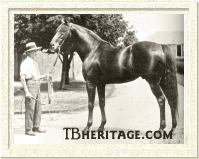
Phalaris as a stallion
| |
Phalaris was a particularly good looking horse. Brown with a large star as his only white marking, he was long barreled, but tremendously muscled in the shoulder and hindquarter, which gave him the appearance of having a dip in his back. If he could be faulted, it was for being slightly back at the knee. He was also blessed with a kind temperament.
Fortunately, he threw his own attractive physical type (most of his stock were "dapper, short-coupled and inclined to be short-legged") and his first foals showed real promise.
|
In 1921, he was moved to Lord Derby's Side Hill Stud (Derby's other stallions, Swynford and Chaucer, stood at nearby Woodland Stud) and his fee raised to 300 guineas. His first crop of yearlings were admired and well received at the sales. When they hit the races in 1922 and proved they had inherited his brilliant speed, Phalaris' fee was bumped up again to 400 guineas, where it remained for the rest of his life.
He was the leading sire of two-year-olds in 1925, 1926, and 1927, leading overall sire twice, in 1925 (the year his Manna won the 2,000 Guineas and Derby Stakes) and 1928 (the year Fairway was a three-year-old). He was also second on the list in 1926, third in 1927, and fourth in 1930. Phalaris demonstrated a profound nick with mares by Lord Derby's homebred Chaucer, and worked well with most of the other stout bloodlines in the Derby stud.
Phalaris died as many stallions do, covering a mare in the breeding shed early in the season. He covered the mare Princess Sublime and dropped dead on February 28, 1931 at the relatively young age of 16 years.
Phalaris' two most important offspring happened to be the full brothers Fairway and Pharos, both bred by Lord Derby out of the Scarborough Stakes winner, Scapa Flow by Chaucer. Scapa Flow was a stayer, winning three times at a mile and a half including once as a two-year-old. Pharos was the most important offspring of his sire; the younger brother Fairway, however, was his best runner on the racecourse.
|
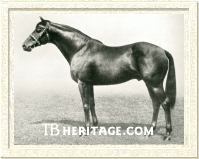
Pharos
| |
PHAROS (b. or br.c. 1920 out of Scapa Flow by Chaucer) was foaled on April 4, 1920, from the first crop sired by Phalaris, and the second foal of her dam. (In 1919, she produced Spithead, a colt, later gelded, by John O'Gaunt, who won the Chester Cup). A neatly-made middleweight, Pharos resembled his grandsire Chaucer more than he did Phalaris. Compact, with good shoulders, good quarters, and full of quality, if he could be faulted, it was for being slightly back at the knee and slightly sickle hocked. He ran four years, from age two to five, proved sound, agile, and dead game.
|
At two, he started nine times and won six of these, all but one victory at five furlongs. He was the fourth-ranked colt of his division on the Free Handicap behind leader Town Guard. At three, Pharos ran another nine times, winning three races: the Hastings Stakes and March Stakes, both at ten furlongs as preps for the Derby -- which he lost by a length and a half to Papyrus -- and Newbury's Royal Stakes over ten furlongs. At four, Pharos won four of seven starts, culminating in the Eclipse Stakes, after wins in the Liverpool Summer Cup, Duke of York Handicap and North Sea Handicap, all at ten furlongs. Considered the best older horse in training, he came back at five to defend the title but was largely unsuccessful, his only win in five starts was a repeat of the Duke of York Handicap. He retired with fourteen wins in 30 career starts and hand-forged a reputation as the best ten furlong horse of his era.
Pharos entered stud in 1926 at Woodland Stud, Newmarket and was shifted to Haras d'Ouilly in France for the 1929 season. He stood there until his death on April 30, 1937 at the age of 17. The leading sire in England in 1931 (when his Cameronian won the 2,000 Guineas and Derby Stakes), he was the leading sire in France in 1939, when Pharis was the overwhelming champion three-year-old.
Pharos'most important son, however, was Italian-bred Nearco, undisputed champion of his crop at two and three in Italy, and one of the greatest racehorses of the Twentieth Century. Nearco's final start was in the Grand Prix de Paris, which he won in demonstrative style, capping an unblemished career of fourteen starts. Retired to stud in England at the end of his three-year-old season, Nearco became one of the most important sires of the century as well, twice leading sire and getting the classic winners Dante, Sayajirao, Nimbus, Masaka, Neasham Belle, and Noory; and other significant individuals in Nasrullah, Nearctic, Royal Charger, and Noorani.
Marcel Boussac's French-bred Pharis is considered one of the greatest French-bred runners of the century. Vastly superior in his three starts at three, all wins, the Prix Noailles, Prix du Jockey Club, and Grand Prix de Paris. A large, rugged horse, Pharis was confiscated by invading Nazi forces in 1940 and used in the German National Stud until the end of the war, when he was returned in 1945. He was an important sire for Boussac, getting Scratch, Pardal, Asterblšte, Ardan, Priam II and numerous others.
Pharos' other top winners included Cameronian (2,000 Guineas, Derby), Firdaussi (St. Leger), Phideas (Irish 2,000 Guineas, Irish Derby), Mary Tudor II (French 1,000 Guineas; dam of Owen Tudor), En Fraud (French Oaks), The Nile (French 1,000 Guineas), Bernina (Italian 1,000 Guineas, Italian Oaks), Semiramide, Brueghel, Fastnet, Rhodes Scholar, El Greco, Bozzetto, Pherozshah, and Rose O'Lynn (dam of Bussion d'Or, Buisson Ardent). |
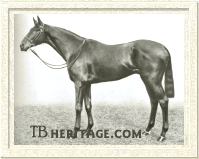
Fairway
| |
Although Pharos was the more influential sire in the long run, FAIRWAY (dk.b.c. 1925 out of Scapa Flow by Chaucer) was the superior of the two brothers on the racecourse. Trainer Lambton noted "Fairway does not resemble his full-brother Pharos in any way except that he has the same beautiful head and intelligent eye. He has taken after his grandsire Polymelus, more than his sire, Phalaris, and is a light-framed colt that in the early part of the season may be difficult to train. I can foresee some anxious moments for Frank Butters. " The latter remark was made because at the time, Lambton was handing the Derby stable over to Butters.
|
Fairway made fifteen starts from two to four, won twelve of the, and was champion all three seasons. At two he won the Coventry, July, and Champagne Stakes. At three, he won the St. Leger, Eclipse, Champion, and Newmarket Stakes, but his nervous temperament caused him to be unplaced in the Derby. At four he won a second running of the Champion Stakes, also the Jockey Club Cup, Princess of Wales's, Burwell, and Rous Memorial Stakes. Kept in training at five, he never started and retired to stud in 1931 at Woodlands Stud, Newmarket, and died here in November of 1948.
Fairway forged a spectacular stud career, leading the lists four times. His best runner was Blue Peter (from the same crop as Pharos' son Pharis), winner of the 2,000 Guineas and Derby Stakes. His other classic winners were Derby winner Watling Street; 2,000 Guineas winners Pay Up, Kingsway, and Garden Path; 1,000 Guineas winner Tide-Way, and Irish 1,000 Guineas winner Annetta. Fairway also sired Fair Trial (a great sire), Hairan, Fair Copy, Full Sail, Meadow, Honeyway, The Yuvaraj, and Dogger Bank, most of these also becoming important international sires. |
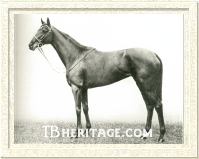
Fair Isle
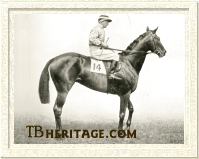
Manna
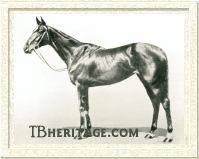
Chatelaine
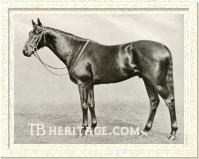
Colorado
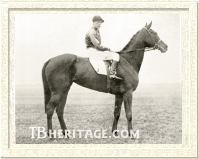
Molly Adare
| |
Pharos and Fairway and a full sister, FAIR ISLE (b.f. 1927 out of Scapa Flow by Chaucer), who won the 1,000 Guineas, and was dam of the sire St. Magnus.
Phalaris also sired MANNA (b.c. 1922 out of Waffles by Buckwheat), winner of the 2,000 Guineas and Derby Stakes (by eight lengths "in a canter") at three. Standing at Banstead Manor Stud, he was a useful sire at best, getting 2,000 Guineas winner Colombo, champion two-year-old Mannamead, Italian great Archidamia, plus Dagherotipia (Italian 1,000 Guineas), and Manitoba. Manna's brother PARWIZ (c. 1925) was a good stakes winner and when sent to Argentina, became a major force in the gene pool there.
Phalaris' daughter CHATELAINE (b.f. 1930 out of Herself by Neil Gow) won the Oaks in 1933, but was not a successful broodmare. Phalaris' son COLORADO (br.c. 1923 out of Canyon by Chaucer) won the 2,000 Guineas and Eclipse Stakes, and was third in the Derby Stakes. He sired only two crops for Lord Derby, but they included Ascot Gold Cup winner Felicitation, Colorado Kid, Furrokh Siyar, Loainingdale, Riot, Canon Law, Coroado, Figaro, and Scarlet Tiger. Colorado's full brother CAERLEON (br.c. 1927 out of Canyon by Chaucer) also won the Eclipse Stakes, but was less effective as a sire.
Another pair of full brothers out of a Chaucer mare made significant marks in the U.S. - *Sickle and *Pharamond II. *SICKLE (br.c. 1924 out of Selene by Chaucer) was the champion two-year-old of his crop, and a classic level miler in England. Sent to the U.S., he became a Leading Sire, getting champions Stagehand and Star Pilot as well as Versicle (sired while still in England), Unbreakable, Misty Isle, Jabot, Hindu Queen, Brevity, Reaping Reward, and Sceneshifter among his best.
*Sickle's brother *PHARAMOND II (b. or br. 1925 out of Selene by Chaucer) was a cut below Sickle in racing class, and about as good as a sire when sent to the U.S., getting champions Menow, Apogee, and By Jimminy; and top class runners like Whopper, King Cole, Creole Maid, Easy Mon, and Athenia.
Phalaris' other major winners included WARDEN OF THE MARCHES (Champion Stakes), PLANTAGO (Coronation Cup), BOLD ARCHER, CARLARIS, PHALAROS, LE PHARE, and FARA (a sister to Pharos, Fairway, and Fair Isle).
Besides establishing himself as a major sire of sires, Phalaris was also the Leading Broodmare sire three times, in 1937, 1940, and 1942. His best producing daughters were Carpet Slipper (dam of Irish Triple Crown winner Windsor Slipper and 1,000 Guineas/Oaks winner Godiva), Bridge of Allan (dam of Derby winner Mid-Day Sun), Garpal (dam of 1,000 Guineas winner Brown Betty), Amuse (dam of 1,000 Guineas winner Picture Play), Mirawala (dam of Becti and Stafaralla), Phaona (dam of *Easton, Hilltown), Pladda (dam of Plassy), Everlasting (dam of Delville Wood), Meadow Rhu, Molly Adare (dam of Fearless Fox, Challenge, Brazen Molly and Queen Christina), Fara, Aidetta, and *Starweed.
|
In his era, the early part of the last century, Phalaris was a phenomenon of speed, and then a sire of brilliance and classicity combined. Even acknowledging this, no one could have anticipated his long term influence would be so dominating. In the current century, the male line of Phalaris dominates world racing like no other, represented by the all the world's greatest sirelines -- Northern Dancer, Raise a Native, Turn-to, Nasrullah, Buckpasser, and many others. And there's no end in sight.
--Anne Peters |
|
|
|

